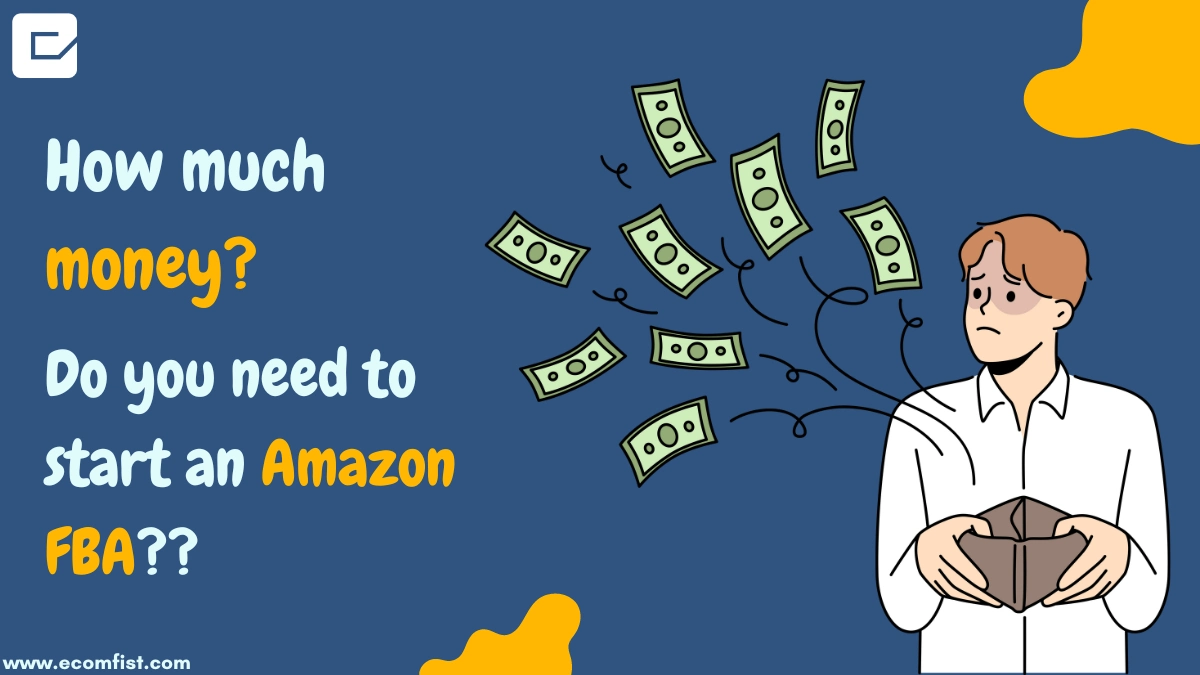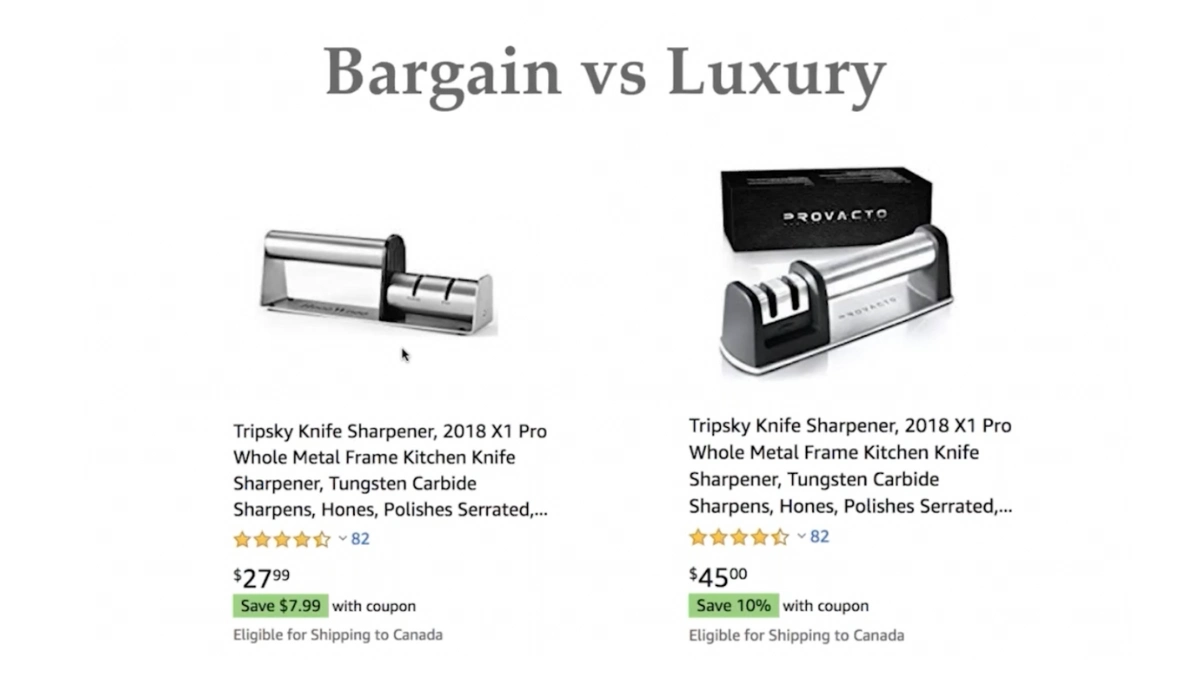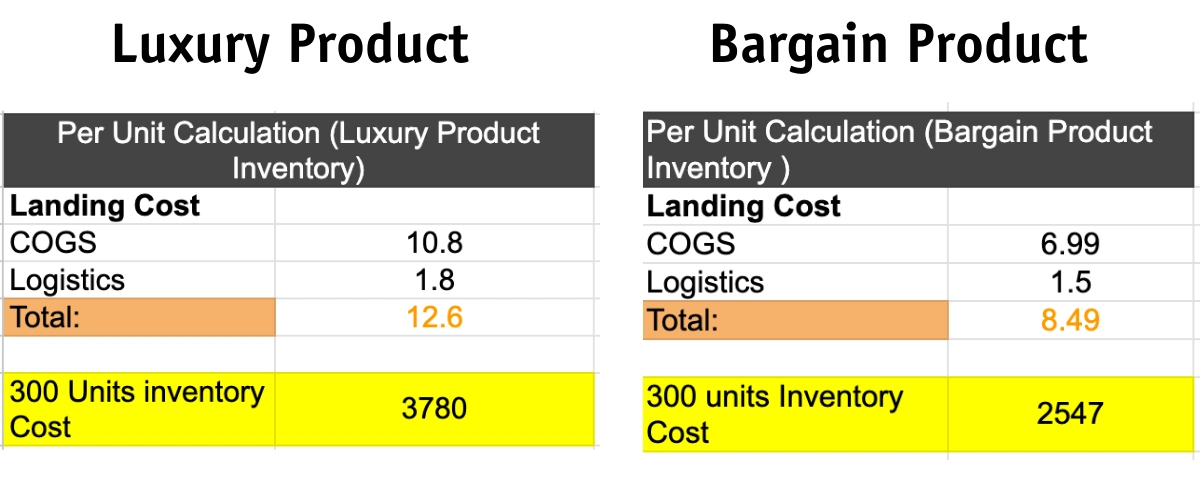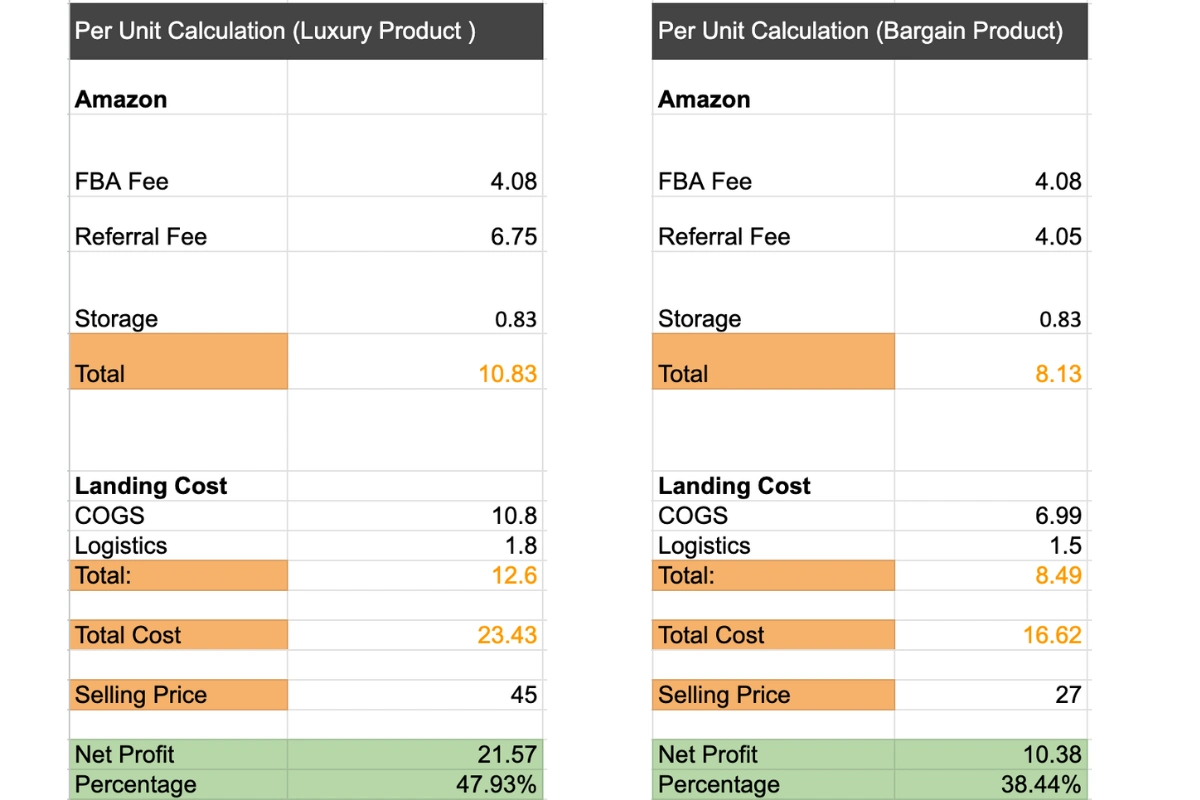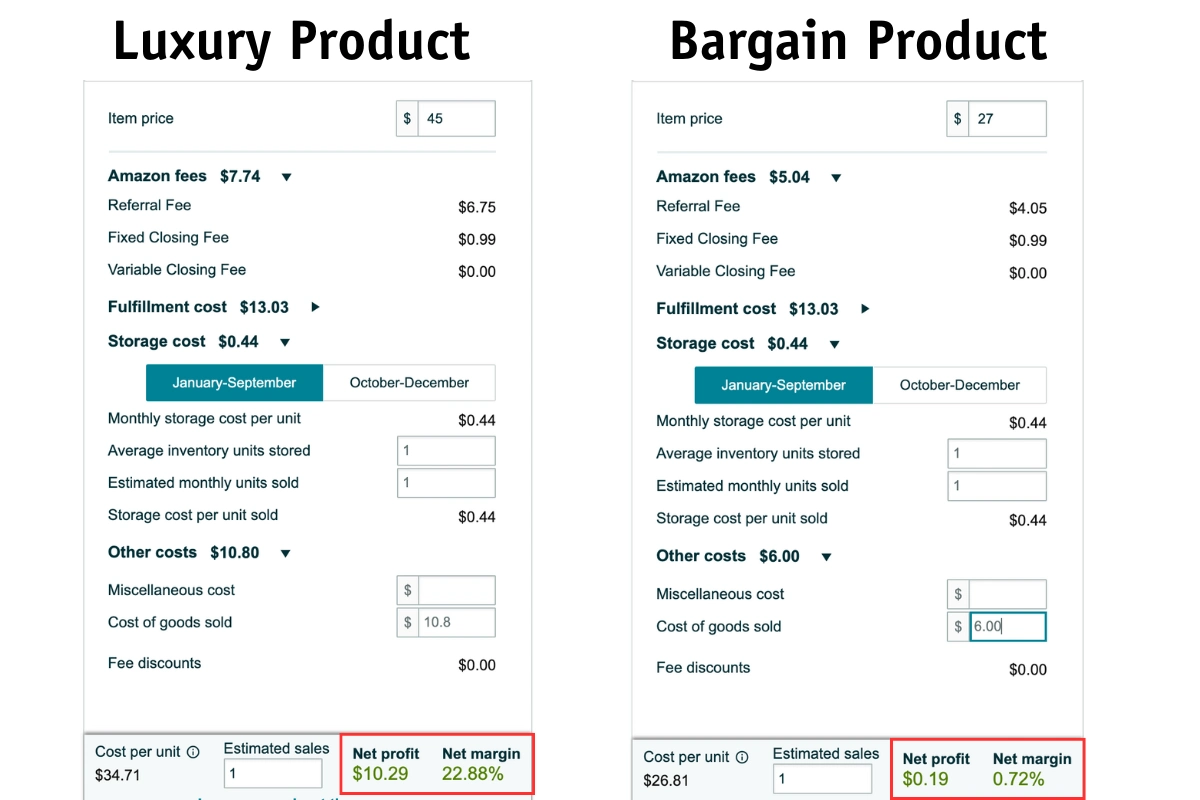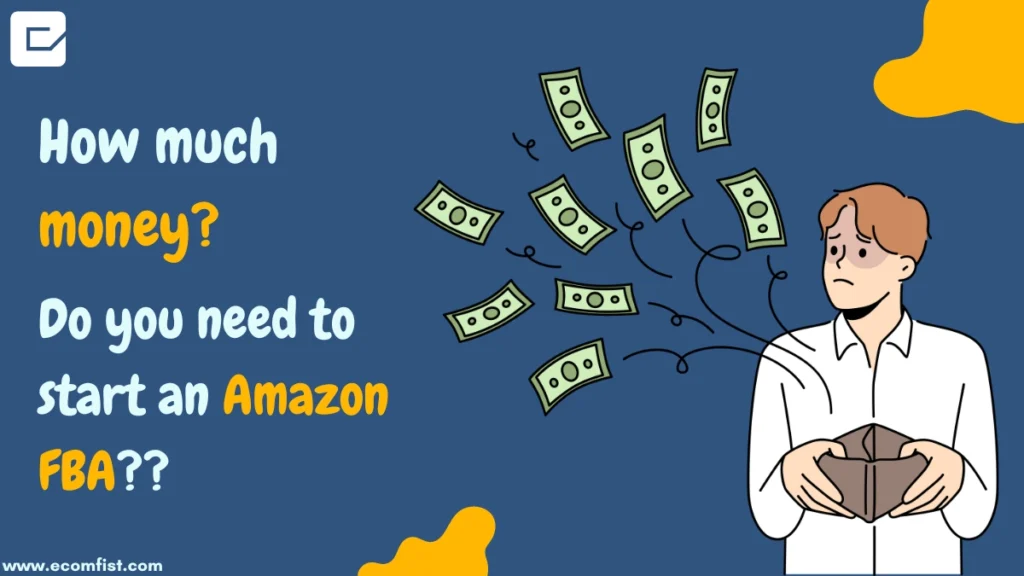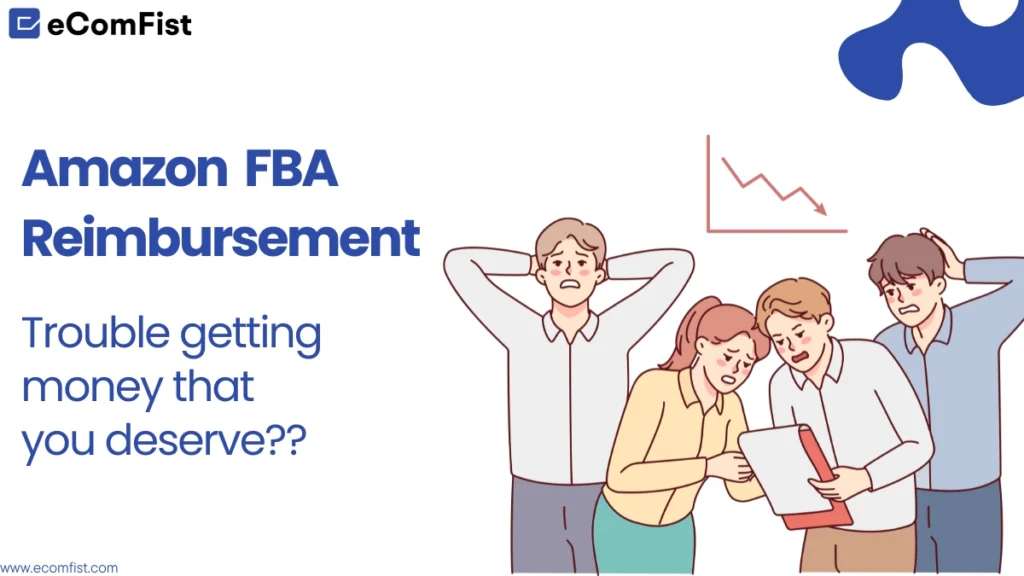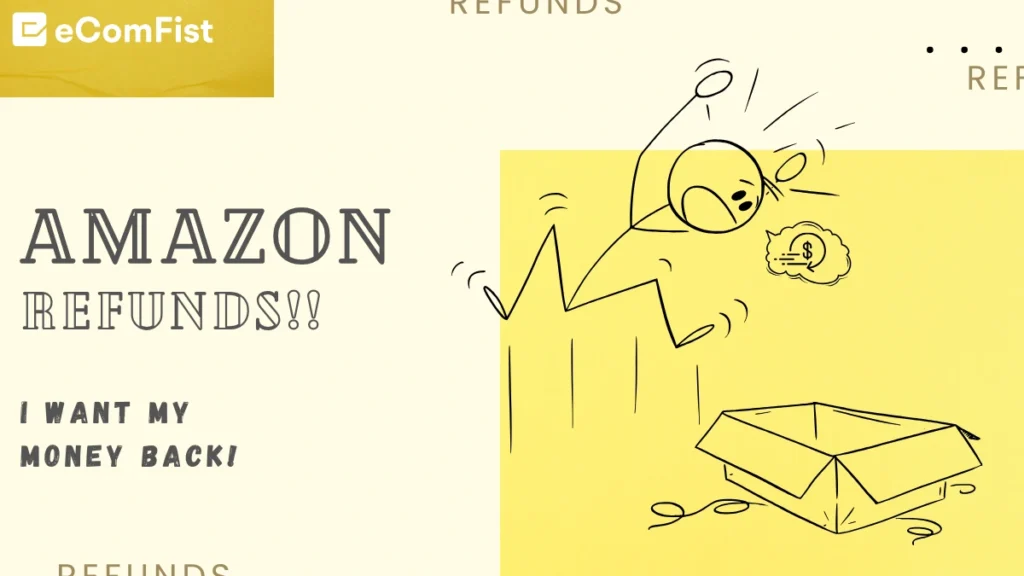In reality, launching the wrong product on Amazon could lead to financial ruin, while hitting the jackpot with the right product could yield profits of 30% or more. In this context, asking, ‘How much money do you need to start an Amazon FBA?’ might seem over-simplistic because your goals aren’t clear. For example, if you’re OKAY with minimal profits of 1% or 2%, you could start with as little as $3000 to $5000 (depending on other criteria, of course). However, if you aim for higher profits and conversion rates exceeding 30%, you might require an investment of $20,000 to $25,000.
Furthermore, it all depends on factors like market saturation, competitor conversion rates, product complexity, keyword volume, risk assessment and other expenses and fees, etc. Considering all these aspects will help determine the cost of launching your product on Amazon. Let’s answer the question: how much money do you need to start Amazon FBA?
Read More
Why do 95% of Amazon sellers fail?
Initial Cost Breakdown For Amazon FBA Private Label
We will breakdown the cost of starting Amazon FBA in two ways:
- Luxury product with more investment and more profit.
- average product with less investment and less profit.
Never lose sight of the fact that your ultimate goal is to make a profit through Amazon FBA. Those who focus solely on costs and ignore profits will inevitably fail within a year or two. The fact that your revenue is going toward covering costs rather than growing your business is illogical. Therefore, we will also discuss it from the perspective of profit.
That’s why we like to break down the whole cost of launching a product on Amazon FBA into three parts: the landing cost, the Amazon fees, and the profit. For both mass-market and high-end product launches, let’s go over these three phases.
Phase 01: Landing Cost
The seller’s overall expenditure on importing a product into Amazon’s fulfillment centers and making it accessible for sale on the marketplace is called the “landing cost.” Included in this total are a number of costs related to the product’s purchase, production, shipment, and storage. It covers 33.3% of the total investment.
It also includes any additional costs that may arise during the shipment and fulfillment process, including product inspection fees, expenses associated with labeling and packaging, insurance, currency conversion fees, and any other unexpected expenses.
(i). Manufacturing Cost | Luxury Product $3780, Bargain Product $2547
To estimate the manufacturing cost of your product, consider the following tips to make the minimum investment for your Amazon FBA business:.
- The product’s manufacturing cost is directly proportional to its quality. The luxury product has a higher manufacturing cost as compared to the bargain product.
- Start with small, unbreakable products that are light in weight and dimensions. The reason is that you will incur higher storage fees and shipping costs per unit based on Amazon FBA oversize dimensions.
- For a big product, you should prepare for a hefty Amazon referral fee or commission. Anyway, it actually depends on the Amazon category or niche.
- If you set the order for a bulk quantity, your manufacturer or supplier may give you a discount.
- Make sure you have enough money on hand to purchase two inventories. For the simple reason that the first inventory doesn’t usually make a ton of money, depending on your sales data from last month, you could need to order additional inventory before the first runs out. The second inventory will cost money. So be prepared.
Let’s suppose there are two products, one “bargain” and one “luxury,” with different selling prices.
The bargain product’s selling price is $27, and the luxury product’s selling price is $45. And suppose you’ll order 300 units of inventory for each. Let’s calculate how much it costs to make an inventory for each product.
Landing cost is 33.3% of the selling price = $27 * 0.33 = $8.99 ≈ 8.4 Minus the shipment cost from the landing cost = 8.4 - 1.5 = $6.9 Total manufacturing cost of 300 units inventory = 300 * 6.9 = $2070
So, for bargain products and luxury products, the inventory cost for 300 units is $2070 and $3240, respectively.
(ii). Shipment Cost
We initially assumed that you would begin with a 300-unit inventory. Remember that shipping prices might change based on a number of factors, including the dimension and mass of your products and the distance they must travel to reach Amazon’s fulfillment centers. So, whenever you plan your FBA business budget, be sure to include the varying shipment expenses in the landing cost. It makes a huge difference in the overall investment. Also, you can reduce expenses and increase profitability over time by investigating various shipping options. Learn how to negotiate the cost with your supplier to improve your logistics plan.
So, the per unit shipment cost of the above product, according to its size, mass, and dimensions, will be $1.5 to $1.8.
Now, let’s calculate the total landing cost for the 300 MOQ.
So, the total landing cost for 300 units of inventory for luxury and bargain products is $3780 and $2547, respectively.
Remember that you’ll need a substantial starting investment in Amazon FBA to cover the two landing charges. For the simple reason that you’ll need to place an order for the second inventory even before the first one is finished. Until then, you won’t have enough money from the first inventory’s sale to pay for the second.
Second round of inventory batch cost for luxury product = $3780 * 2 = $7560 Second round of inventory batch cost for bargain product = $2547 * 2 = $5094
It’s like there is a $1k difference in investment between a luxury and a bargain product. But the reality will appear to you at the end of the blog.
02: Product Sampling Cost | $100 to $300
Most sellers see this step as a waste of money because their initial investment in Amazon FBA is small. So, they just ignore this step. But the truth is that your product’s odds of success increase in proportion to the number of samples you order, the number of revisions you make, and the number of modifications you seek from suppliers. There will be a slight increase in FBA investment due to the increased demand for improvements. But in the beginning, if you just order samples and examine them carefully to make sure they meet your requirements, it will make a big difference to your product rating.
You should budget $100 to $300 for this order sampling since it will be well worth it in the end.
03: Inspection cost | $200 to $300
For most of the sellers, it’s OKAY not to inspect their inventory.
Why?
Because sellers ship their inventory overseas, go live on Amazon, and everything goes great. A year passes, and profits are rolling in. But then, boom! Minor defects start showing up, one-star ratings pour in, and Amazon suspends the listings.
So, just to save a few bucks on your Amazon FBA investment, you lost your entire Amazon FBA private label business. Of course, you won’t even imagine doing that.
So, inspection is not just necessary; rather, it’s the blood of your Amazon FBA business. Spending $200 to $300 will protect you from losing your fortune in later life.
For the second round of inventory, you must cover the cost of your initial investment in Amazon FBA. So, the cost will become $400 and $600.
04: GS1 Barcode | $30
Is it GS1, UPC, or GTIN? These are the different names of the barcodes that give each product its own identity. This barcode was previously known as UPC, but Amazon now mandates that your UPC include the prefix of the GS1 company. This change occurred after the GS1 company established standards for barcodes. In short, this 13-digit barcode ensures each product’s unique identification, minimizing errors in inventory management, order fulfillment, and product tracking. In addition to strengthening Amazon’s operational efficiency, GS1 barcodes give customers peace of mind regarding the authenticity and trackability of the items they purchase.
Now, we have planned to launch a single product. The GS1 barcode, then, is available for just $30. No fee is required to renew. So, your initial Amazon FBA investment seems unaffected by the $30. However, if you have more than one product available, the cost and renewal price will increase.
Also, this GS1 barcode cost is the same for luxury and bargain products. Do not forget that you have to buy it. Without this, Amazon will not allow you to list your products.
Design Work And Product Photography | $400-$500
A one-time expense like this is unavoidable.
You should prepare yourself to compete against multiple sellers who have exceptional product listings. Customers will base their judgments on graphics, images, brand overviews, and product descriptions because they cannot physically touch the product.
Therefore, it is crucial that you use the services of a professional photographer and designer. They can create logos, packaging designs, product inserts, photo touch-ups, infographics, and high-quality product photographs for your listings. You should expect to pay around $400 to $500 for this.
Advertisement Cost | $900
PPC advertising is a must for Amazon sellers who want to make an impact in the platform’s cutthroat environment. PPC ads show your products at the top of search results, drawing in customers. This exposure is significant, particularly for newly listed items without a solid track record of sales or many reviews. Also, it speeds up the process of generating organic traffic, which is dependent on factors like keyword relevancy and sales velocity.
Someone who tells you that you don’t need to spend money on PPC at the beginning is the silliest person in the world. What this means is that you will waste the honeymoon period when Amazon will provide you with ample customer exposure. Amazon may suspend your listings due to poor seller rank if you don’t earn sales initially.
On top of that, Amazon bidding is incredibly pricey these days. Even if your product isn’t in a very competitive market, you still need to set aside at least $20 to $30 daily to run pay-per-click (PPC) ads (sponsored product, sponsored brand, product display ads). On the other hand, if your product is in a really competitive niche, there’s no predefined daily budget. It may cost as little as $80 or as much as $120.
Get more knowledge regarding Amazon PPC:
- 07 most profitable Amazon PPC campaign secrets you should know at all costs
- Top sponsored Product ad placement hacks for 2024
- Amazon sponsored brand ads: 5 must-see 2023 trends you can’t miss
Therefore, be thorough in your product research to determine whether your product is in an overly competitive market or a less competitive one. This careful evaluation will help you plan and budget effectively for your PPC campaigns.
Here, we have completed the first part of the cost of launching a product on Amazon FBA. Now move on to the second part.
Phase 02: Amazon Fees
This part will take 33.3% of your FBA investment. During this phase of your Amazon product launch, you need to pay monthly Seller Central fees. Additionally, you must cover the one-time cost of the Amazon Brand Registry. It’s also important to account for other fees, such as referral and commission fees, which are deducted on a per-unit sale basis rather than from your initial FBA investment. With these costs in mind, you may estimate how much of a starting investment outlay you’ll need to make a decent profit.
1. Amazon Seller Account | $39.99/month
Of course, you should already know that getting an Amazon seller account is the first step in selling on Amazon You can choose from two different seller plans. One of them is the individual seller plan. Which is free of charge, but you’ll have to fork over $0.99 for every item you sell. Second, there’s the $39.99/month professional seller plan. Because the Professional plan grants you access to all the other features, like being able to do coupons, promotions, and access to the Amazon PPC system, it is the ideal choice. Also, if you sell 40 items or more per month, the cost won’t be worth it at all.
Note: The general consensus is that you should begin your sales journey with the individual plan and upgrade to the professional one later on. However, we advise against it because we need to start Amazon PPC right after the launch in order to rank our listings during honeymoon time.
The initial FBA investment must cover this fee. Therefore, $39.99/month will be the cost of an Amazon seller account for two months.
2. Amazon FBA Fees
These are the fees that Amazon will deduct from your total for product selection, packaging, and shipment. After you ship your inventory to Amazon’s warehouse, they will charge you a service fee to cover the costs of their fulfillment service. This fee is calculated based on your product’s size and weight.
The dimensions of the bargain and luxuary product in this case fall within large standard dimensions, and the weight is between 6 and 8 ounces, which costs $4.08.
If you want to keep the Amazon fees down when launching your products, you should make sure they aren’t too big or too heavy.
3. Amazon brand registry
The Amazon brand registry gives you an edge in the following ways:
- It makes your listing more secure and less susceptible to “hijackers” (i.e., those trying to sell something on your listing). Until you have a successful item, this won’t be an issue. No matter how unique your product is, someone will always figure out a way to copy it.
- It allows you to use some features and access certain tools that aren’t available without it (such as A+ material, certain advertising settings, etc.).
It seems to me that you could get by just fine without the brand registration at first. You may take things seriously after you start making money and understand how everything works. While you’re still in the beginning stages, it’s wise to keep your expenses low.
Otherwise, the brand registry will cost you $225 to $400.
4. Referral Fees | 15%
It’s the biggest fee that you pay to Amazon. Actually, referral fee the commission that Amazon receives from you for using their platform to sell. It deducts from the sale of every unit. It hovers around 15% most of the time. It depends on the price at which you’re selling.
Referral fee for the bargain product = 27 *15% = 4.05 Referral fee for the luxury product = 45 * 15% = 6.75
If you sign up for the brand referral incentive program, you can reduce this astronomical referral fee. To participate in this program, you must direct buyers to your listings on places other than Amazon. Actually, by driving traffic to Amazon’s platform, they will lower your referral fee as a bonus. But it’s better not to experience it from the very start.
5. Amazon Storage Fee
As soon as your Amazon FBA business launches, you will begin making use of Amazon’s limited warehouse space. Plus, Amazon will tack on a fee. It is dependent on the product’s size and the category into which it falls.
As a result, our storage price for both luxury and bargain products is $0.44 each. We won’t have to worry about paying any additional storage fees for our product to remain in the Amazon warehouse in the long term (more than 365 days) because we are just ordering 300 MOQ.
If you want to start an Amazon FBA business, you’ll have to pay these fees. The costs vary based on your expertise, product selling price, category, size, and other factors
Surprise Fees You Might Encounter on Amazon
It is typical for Amazon FBA businesses to face unexpected fees that add up over time. The following is a rundown of the unwelcome costs:
1. Removal Orders
If your inventory remains in the warehouse for over 365 days, it’s more cost-effective to issue removal orders instead of paying monthly long-term storage fees. However, removal orders also incur costs based on the size and tier of the product. For a knife sharpener, the removal order fee per unit would be $0.50.
2. Disposal Fee
You might face a disposal fee if a customer returns a damaged product or the items in the inventory get damaged. In such cases, you’ve got to face the loss of the landing cost and you’ll also need to cover the disposal fee to get rid of the damaged items.
3. Customer Return Fees
Customer returns are quite common on Amazon, often for unexpected reasons. In these situations, Amazon only reimburses a small portion of the fee, not the full amount. No matter what you do with the returned product—sell it again or dispose of it—you’ll lose money.
To minimize customer returns, follow these three tips:
- Inspect your inventory to ensure only high-quality items reach customers.
- Use robust packaging to protect products from damage during shipping and returns.
- Provide clear and accurate product descriptions in your listings to set proper customer expectations.
4. Prep Fee | Unplanned Service Fees
If the manufacturer forgot to apply the label, Amazon can fix it for you, but there’s a prep cost that might mount up. Similarly, Amazon will offer to bag, bubble wrap, and tape your items for an unexpected service fee—which can be very substantial—if you haven’t already done so.
5. Inventory Placement Fee
Beginners who are trying to save money on their initial FBA investment frequently encounter this fee. If a seller opts to ship all inventory to a single Amazon warehouse by selecting the “inventory placement service” in the inbound settings, they will have to pay $0.30 per unit for Amazon to distribute the inventory to multiple warehouses. It’s more cost-effective to choose the “distributed inventory placement” option instead.
These are some of the fees that you might encounter if you are totally new without any experience in the Amazon FBA.
Total Required Cost to sell on Amazon
Now it’s time to add up all of the costs that we’ve discussed so far, so you can see how much money you need to start Amazon FBA.
| Luxury Product | Bargain Product | |
| Landing Cost x 2 | $7560 | $5094 |
| Inspection Cost | $200 to $300 | $200 to $300 |
| Product Sampling Cost | $200 to $300 | $200 to $300 |
| GS1 Barcode Cost | $30 | $30 |
| Design work and Photography | $400 to $500 | $400 to $500 |
| Advertisement Cost | $900 – $3000 | $900- $3000 |
| Amazon Seller Account | $39.99 | $39.99 |
| Total | $8530 | $5,664 |
Now, the minimum initial FBA investment for luxury products is $8530, and the minimum initial investment for cheap products is $5664. Therefore, you can opt to sell bargain products if you are on a tight budget. However, if you go below that investment, your profit will be ruined. Simply put, profit is what matters in the end. Why? Because the whole point of getting your Amazon FBA business off the ground is to make money.
Let’s go on to the third step and learn everything about profit.
Phase 03: Profit Calculation
Your Amazon FBA business will remain lifeless unless you start making a profit. Just think about how much work and investment goes into making listings, keeping track of inventory, and handling customer returns if you end up breaking even or even losing money. Very unpleasant.
Running a business without generating a profit drains your initial FBA investment. Without a profit, your Amazon FBA business is not even a business.
So, before you invest in a product, you must calculate the profit. So, let’s calculate the profit of the luxury and bargain products that we have been discussing so far.
(i). Estimated Manual Profit Calculation
Here’s our profit calculation considering the major expenses: The net profit for the luxury product is 21%, while for the bargain product, it’s 10%.
(ii). Calculation Via Amazon Revenue calculator
The Amazon revenue calculator showed a totally different net profit by considering every little bit of fee and expense. And this calculator showed only 10% profit for luxury products and almost no profit for bargain products.
Most Amazon FBA businesses set a target profit margin of 20% to 25%. But this only considered the profit margin and not all of the expenses of running the FBA business. After deducting all costs, the actual profit margin was much lower.
If, in the beginning, after deducting all costs, you are making a profit of 10% to 15%, then you are doing well. However, you shouldn’t settle for a profit margin of 0%.
What is the minimum investment in Amazon?
The minimum investment for an Amazon FBA business is between $7000 and $10,000. Investing less than this typically leaves you with no profit margin unless you’re extremely fortunate and choose a product in a non-competitive market with high sales volume, where you don’t need to spend much on Amazon PPC or landing costs.
I’ve compared low investment products with high investment ones within the same niche, and the profit difference is clear. Otherwise, you might find yourself asking, “Why isn’t my product selling? Why am I losing money on ads? Why is my investment being wasted on customer refunds?” or dealing with low-quality issues. This isn’t how an Amazon FBA private label business should operate.
So, sellers who claim that the minimum investment for starting an Amazon FBA business is $2000 or $3000 are likely not telling the whole story. They might have certain advantages:
- They may be operating in China where manufacturing and shipping costs are lower. This can significantly reduce their initial expenses compared to sellers sourcing products from other regions.
- It’s possible that their YouTube videos or blog posts are outdated. The Amazon marketplace is constantly evolving, with increasing competition and rising costs for advertising and fulfillment. What might have been a feasible investment a few years ago may no longer be sufficient to achieve success today.
- These sellers may not actually be making a profit with such a low investment. The reality is that to stand out on Amazon, you need to invest in high-quality product listings, effective PPC campaigns, and solid inventory management. A $2000 to $3000 investment might cover some basics, but it often falls short of covering all necessary expenses to ensure profitability and long-term success.
In contrast, a higher investment of $7000 to $10,000 allows for better product quality, more robust marketing efforts, and a greater buffer for handling unforeseen costs like returns or additional advertising spend. This level of investment increases your chances of building a sustainable and profitable Amazon FBA business, avoiding the pitfalls of underfunding and inadequate market presence.
So, how much do you need to start selling on Amazon FBA?
Based on our research and the figures shown above, the bare minimum investment required to launch an Amazon FBA business is between $7000 and $8000.
Why not invest $3000 or $5000? Because the profit margins are very low at that level. Plus, when you’re just starting out, it’s certain that you’ll make some blunders that will increase the overall cost.
When you work with experts, though, they may protect you from the kinds of inexperienced errors that might end up costing you some serious money. Professionals can save you money by doing successful product research, running cost-effective PPC ads, and preventing other forms of financial waste.
Get our experience. Get a free consultation.
Related Articles

